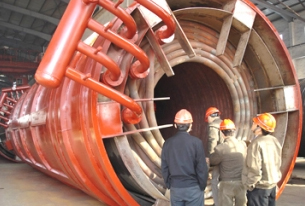1. Introduction to molten salt furnace
Molten salt boiler uses ternary or binary inorganic molten salt (a mixture of potassium nitrate, sodium nitrate, sodium nitrite, etc.) as the heat transfer medium, uses coal, oil or gas as fuel for heating, and uses a molten salt circulation pump to force the liquid phase Circulation, the heat energy is delivered to the heating equipment and then returned to the special industrial boiler for reheating. The entire boiler system is mainly composed of molten salt circulation system, combustion chamber system and heating system. Molten salt working temperature ranges from 250°C to 580°C.
2. Classification of molten salt furnaces
The structure of the molten salt furnace is generally coil type, that is, the molten salt flows in the coil along the furnace body. With the development of industrial production and technological progress, the following classification methods have been formed.
2.1 Classification according to the circulation method of molten salt furnace
It can be divided into natural circulation molten salt furnace and forced circulation molten salt furnace;
2.2 According to different heat sources
It can be divided into coal-fired, oil-fired, gas-fired, electric-heated molten salt furnaces, etc.;
2.3 Classification according to the structural form of molten salt furnaces
It can be divided into cylindrical, square box and tube frame molten salt furnaces;
2.4 Classification according to the overall placement form of molten salt furnace
It can be divided into vertical molten salt furnace and horizontal molten salt furnace.
3. Refractory material configuration plan for molten salt furnace combustion chamber
The combustion system of a coal-fired molten salt furnace consists of a grate, a combustion chamber, a ventilation device, a coal serving mechanism, a slag discharging mechanism, a chimney, etc.
The combustion system of a fuel (gas) molten salt furnace is relatively simple and mainly consists of a burner, an explosion-proof door, a chimney, etc.
3.1 Material requirements for combustion holes and furnace top
Its long-term use temperature is 1350℃, and it needs to have good thermal shock stability, using mullite castable.
3.2 Material requirements for the bottom of the combustion chamber
The bottom uses high-aluminum wear-resistant castable.
3.2 Requirements for insulation materials on top of pipes and around burner holes
The thinnest part of the insulation layer at the top of the coil is only 250mm. It is necessary to ensure long-term use and reduce the temperature of the furnace top guard plate to below 100°C.



